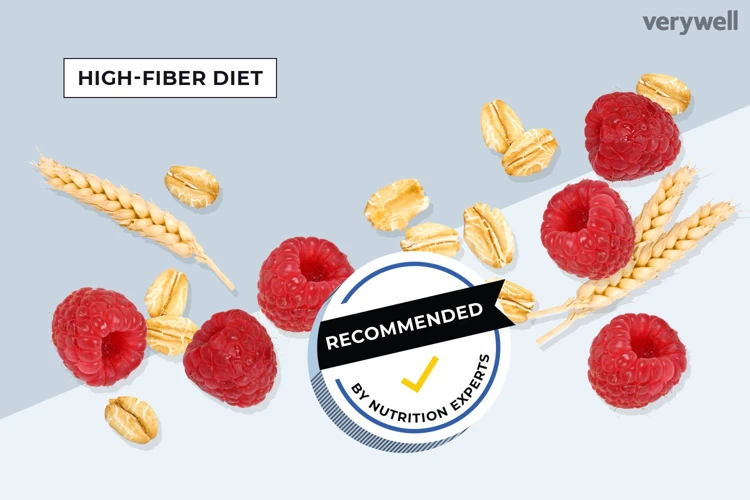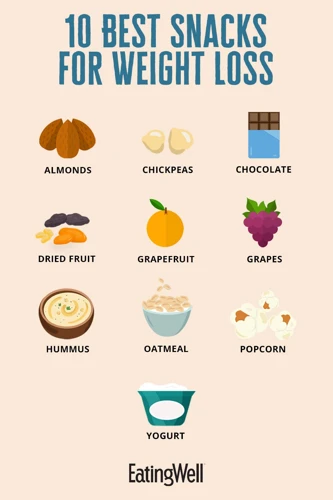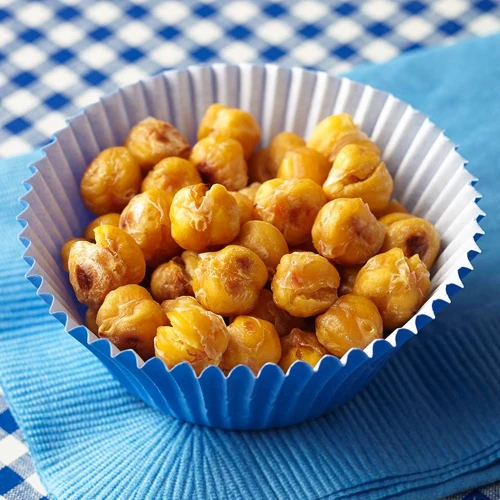The Benefits of High-Fiber, Low-Calorie Snacks

Snacking between meals is a common practice that many people engage in. Unfortunately, most people tend to choose snack foods that are high in calories, sugar, and unhealthy fats. These types of snacks can lead to weight gain and related health problems. However, opting for high-fiber, low-calorie snacks is a smart choice for weight management and overall health.
High-fiber snacks are a great choice because they take longer to digest, making you feel fuller for longer periods, which can help prevent overeating. When you consume high-fiber foods, they expand in your stomach, giving you a feeling of fullness, which means you will eat less. Additionally, high-fiber snacks maintain steady blood sugar levels and help prevent sudden blood sugar spikes and crashes that lead to cravings for unhealthy foods.
Low-calorie snacks are essential for weight management because they allow you to satiate your hunger without consuming too many calories. Low-calorie snacks ensure that you do not exceed your daily calorie intake, which is crucial when trying to lose or maintain weight. A snack that is low in calories can be satisfying, especially when it is packed with protein and fiber.
The benefits of high-fiber, low-calorie snacks extend beyond weight management. Incorporating these types of snacks into your diet can lead to improved digestion and gut health. Fiber-rich snacks stimulate the growth of healthy gut bacteria, which aids digestion and reduces inflammation. These snacks also help control cholesterol and promote good heart health.
Opting for high-fiber, low-calorie snacks is an excellent strategy for weight management and general health. These snacks are satisfying, nourishing, and can help prevent overeating and unhealthy snacking. By choosing the right types of snacks, you can maintain a healthy weight, improve digestion, and reduce the risk of chronic diseases.
How to Choose the Best Snacks for Weight Management

When it comes to weight management, choosing the right snacks is crucial. Not all snacks are created equal, and some can easily derail your weight loss efforts. To ensure that you’re making the best snack choices for your health and weight goals, here are some tips to keep in mind:
Focus on nutrient density: Nutrient-dense snacks are those that pack a lot of vitamins, minerals, and fiber into relatively few calories. One great example of a nutrient-dense snack is fresh fruit. Rather than reaching for a bag of chips, opt for an apple, some berries or a handful of grapes. These will help fill you up, provide a boost of energy, and nourish your body at the same time.
Avoid heavily processed snacks: Highly processed snacks, such as candy bars, chips, and cookies, typically contain a lot of added sugars and unhealthy fats. These snacks are typically high in calories but low in nutrition, meaning they won’t satisfy your hunger and may lead to overeating. Instead, try reaching for whole foods like vegetables, fruits, and nuts that are minimally processed.
Read labels carefully: When choosing packaged snacks, be sure to read the nutrition label carefully. Look for snacks that are low in saturated fat, added sugars, and sodium. Try to choose snacks that provide at least 3g of fiber per serving, as fiber will help keep you full for longer.
Consider portion sizes: Even healthy snacks can be high in calories if you overdo it. Be mindful of serving sizes and aim for snacks that are around 150-200 calories. Pre-packaged snacks can help with portion control, and you can also make your own snack packs by portioning out nuts, veggies or fruits into small containers.
By keeping these tips in mind, you can choose snacks that will support your weight management goals, rather than hinder them.
Low-Calorie, High-Fiber Snacks to Try

Are you searching for healthy snack options to aid in your weight management journey? Look no further than these low-calorie, high-fiber snacks. Not only will they satisfy your hunger cravings, they will also provide important nutrients and fiber to keep you feeling fuller for longer periods of time. And the best part? You won’t have to sacrifice taste for health with these delicious snack options. So, take a look at our list of snack ideas that are sure to become some of your new go-to favorites.
Fruits and Vegetables
When it comes to low-calorie, high-fiber snacks for weight management, fruits and vegetables are a top choice. Not only are they nutrient-dense, but they also provide a satisfying crunch and natural sweetness. Here are some options to consider:
- Apples: With only 95 calories and 4 grams of fiber per medium-sized fruit, apples are a great snack option. Plus, they’re portable and easy to pack on the go.
- Carrots: Carrots are a low-calorie vegetable that’s packed with fiber and other essential nutrients. Dip them in hummus or Greek yogurt dip for a protein boost.
- Cucumbers: Cucumbers are low in calories and high in water content, making them a refreshing snack option. Sprinkle some salt and pepper on top for added flavor.
- Berries: Berries like strawberries, blueberries, and raspberries are high in fiber and antioxidants, making them a great choice for snacking. Plus, they’re naturally sweet and can satisfy a sweet tooth without added sugars.
- Bell Peppers: Bell peppers are low in calories and high in fiber, making them a great snack option. Slice them up and dip them in salsa or guacamole for an added flavor kick.
Incorporating more fruits and vegetables into your diet not only helps with weight management, but it also has numerous health benefits. Try including a variety of colorful options to ensure a diverse range of nutrients in your diet.
Whole Grain Snacks
Whole grain snacks are a great option for those looking for high-fiber snacks that can aid in weight management. They are rich in complex carbohydrates, fiber, vitamins, and minerals, making them a nutrient-dense choice for snacking. Some of the best whole-grain snacks to consider include:
| Whole Grain Snacks | Calories per serving | Fiber per serving |
|---|---|---|
| Popcorn | 31 calories | 1.2 grams |
| Whole grain crackers | 120 calories | 3 grams |
| Granola bars | 120-200 calories | 2-4 grams |
| Brown rice cakes | 35 calories | 0.5 grams |
| Rye crisps | 60 calories | 3 grams |
Popcorn is an excellent choice for snacking as it is low in calories and high in fiber. Plus, it is a whole grain food that is rich in antioxidants. It is important to note that popcorn is a great snack when it is prepared plain, without butter or salt.
Whole grain crackers are another option to consider, as they are quick and easy to grab when you’re on-the-go. They are available in various flavors and are a good source of fiber. However, be sure to check the nutrition label and ingredient list to ensure that you are selecting whole grain crackers with minimal additives.
Granola bars can be a convenient snack that is easy to pack and take with you. Look for granola bars that are rich in oats, nuts, and seeds to get a nutritious snack that will also help to keep you feeling satisfied. Be cautious of granola bars that are high in sugar or artificial ingredients.
Brown rice cakes are a satisfying and low-calorie snack that is perfect for those who are looking for a gluten-free or low-fat option. They can be topped with various flavor enhancers like nut butter, hummus, or avocado for added taste and nutrition.
Rye crisps are a crispy and crunchy whole grain snack that is perfect for dipping in hummus, salsa, or guacamole. They are relatively low in calories and high in fiber, making them an excellent option for those trying to manage their weight.
Nuts and Seeds
Nuts and seeds are an excellent source of healthy fats, protein, and fiber. They can be incorporated into your daily diet as a great snack option for weight management. Here are some examples of low-calorie, high-fiber nuts and seeds:
| Name | Calories (per oz) | Fiber (grams per oz) |
|---|---|---|
| Almonds | 161 | 3.5 |
| Walnuts | 183 | 1.9 |
| Pistachios | 156 | 2.9 |
| Chia Seeds | 138 | 10.6 |
| Pumpkin Seeds | 148 | 1.7 |
| Sunflower Seeds | 165 | 2.4 |
Nuts and seeds make a great snack option that can be eaten on their own or sprinkled on top of yogurt or a salad. Just be sure to watch your portion sizes as they can be high in calories. The recommended serving size for nuts is usually around 1 ounce, which is roughly a handful, and it’s best to avoid nuts or seeds that are coated with sugar, salt or have added flavors or seasoning.
Low-Fat Dairy Products
Low-fat dairy products are a great source of protein and calcium, making them an excellent option for healthy snacking. Incorporating low-fat dairy products into your diet can also help you feel full and satisfied. Here are some examples of low-fat dairy snacks to try:
- Greek yogurt: Greek yogurt is packed with protein, calcium, and other essential vitamins and minerals. Choose plain, unsweetened varieties to avoid added sugars. You can mix in fresh fruit or unsweetened granola for added texture and flavor.
- Cottage cheese: Cottage cheese is rich in protein and low in fat. You can top it with fresh fruit, nuts or seeds for an added crunch.
- String cheese: String cheese is a convenient and portable snack option that is low in calories and high in protein. Pair it with an apple or pear to add some natural sweetness and fiber to your snack.
- Low-fat milk: Low-fat milk is an excellent source of calcium and vitamin D. You can enjoy a cold glass of milk with a few whole-grain crackers or a piece of fruit for a nutritious snack.
- Smoothies: Smoothies made with low-fat milk or Greek yogurt and fresh fruit are a delicious and satisfying snack option. You can blend in some spinach or kale for added fiber and nutrients.
When selecting dairy products, it is important to choose low-fat or fat-free varieties to minimize calorie intake. Additionally, watch out for added sugars in flavored yogurts and milk products. Opt for plain, unsweetened varieties and add your own natural sweeteners, such as fresh fruit or a drizzle of honey. Incorporating low-fat dairy snacks into your diet can help you reach your weight management goals while also providing essential nutrients and keeping you feeling full and satisfied.
Other Snack Ideas
When it comes to snacking, there are plenty of options beyond just fruits, vegetables, whole grains, nuts, and low-fat dairy products. Here are some other snack ideas to consider:
- Popcorn: Air-popped popcorn is a low-calorie snack option that can be a great source of fiber. Avoid pre-packaged microwave popcorn, as it often contains added oils and salt.
- Rice cakes: Rice cakes can be a satisfying and low-calorie snack option. Look for brands that are made with whole grains and without added sugars.
- Jerky: Beef jerky, turkey jerky, and even salmon jerky are high-protein, low-calorie snacks that can help keep you feeling full. Be sure to choose varieties that are low in added sugars and sodium.
- Roasted chickpeas: Chickpeas are a great source of fiber and protein. Roast them with your favorite seasonings for a crunchy snack that hits the spot.
- Rice crackers: Rice crackers can be a satisfying and crunchy snack option. Look for varieties that are made with brown rice and without added sugars or oils.
- Hard-boiled eggs: Hard-boiled eggs are a high-protein snack that can help keep you feeling full. Sprinkle them with a little salt and pepper or your favorite seasonings for extra flavor.
Remember to pay attention to portion sizes and to choose snacks that fit within your daily calorie and nutritional goals. Mixing and matching different snack options can help keep things interesting and satisfying.
Healthy Snacking Tips for Weight Loss Success
When it comes to snacking for weight loss, it’s important to keep a few key tips in mind to ensure success in your goals. First and foremost, it’s important to pay attention to portion sizes. Even healthy snacks can contribute to weight gain if you’re consuming too much of them. Using measuring cups or a food scale can help you ensure that you’re not overeating.
Another important tip is to plan ahead. Having healthy snacks readily available can make it easier to avoid less healthy options. Try prepping snacks at the beginning of the week, so that you have healthy options easily accessible when hunger strikes.
It’s also important to listen to your hunger cues. Often, we can mistake thirst or boredom for hunger. Before reaching for a snack, ask yourself if you’re truly hungry or if there’s something else going on. Drinking a glass of water or engaging in a distracting activity can help you determine if you’re actually hungry.
To keep snacking healthy, choose foods with high nutritional value. Snacking on fruits and vegetables, whole grains, low-fat dairy products, and lean protein sources can help you stay full and satisfied while also providing important nutrients that support overall health.
One final tip for healthy snacking is to avoid distractions while eating. Mindless snacking in front of the TV or computer can lead to overeating without even realizing it. Instead, take a mindful approach to snacking by sitting down at a table and focusing on your food. This can help you avoid overeating and enjoy your snacks more fully.
By incorporating these healthy snacking tips into your routine, you can enjoy delicious snacks while still working towards your weight loss goals.
Conclusion
In conclusion, incorporating low-calorie, high-fiber snacks into your diet can be an effective strategy for weight management. These snacks help to promote feelings of fullness, reduce calorie intake, and provide essential nutrients that support overall health.
Remember to choose snacks that are nutrient-dense and contain a good balance of macronutrients. This includes incorporating fruits and vegetables, whole grains, nuts and seeds, and low-fat dairy products into your snacking routine.
In addition to choosing healthy snack options, there are several tips you can follow to promote successful weight loss when snacking. These include keeping portion sizes in check, planning ahead, and avoiding distractions while eating.
Overall, by making smart, mindful choices when it comes to snacking, you can achieve your weight loss goals and feel satisfied and energized throughout the day. So, give these low-calorie, high-fiber snack ideas a try and enjoy the benefits of a healthy, well-balanced diet.
Frequently Asked Questions
What are the benefits of consuming high-fiber, low-calorie snacks?
Consuming high-fiber, low-calorie snacks has numerous benefits, including weight management, improved digestion, and increased feelings of fullness and satiety.
What should I consider when choosing the best snacks for weight management?
When choosing snacks for weight management, it is important to look for snacks that are low in calories and high in fiber. You should also consider the nutritional value of the snack and choose options that are nutrient-dense.
What are some examples of low-calorie, high-fiber snacks?
Examples of low-calorie, high-fiber snacks include fruits and vegetables, whole-grain snacks, nuts and seeds, and low-fat dairy products.
Is it better to choose fresh or canned fruits and vegetables as snacks?
While fresh fruits and vegetables are ideal, canned options can also be a good choice for snacks as long as they are canned in water or their own juices and do not contain added sugars or syrups.
Are popcorn and rice cakes good options for low-calorie snacks?
Popcorn and rice cakes can be good options for low-calorie snacks as long as they are not heavily salted or flavored. Look for plain options and consider adding your own seasonings.
What are some ways to add flavor to low-calorie, high-fiber snacks?
Some ways to add flavor to low-calorie, high-fiber snacks include adding spices and herbs, using dips and spreads, and experimenting with different combinations of fruits and vegetables.
Is it okay to snack throughout the day?
Snacking throughout the day can be okay as long as you choose healthy, low-calorie options and watch your overall calorie intake. It can also help keep your metabolism up and prevent overeating at mealtimes.
Can low-fat dairy products be a good snack option?
Yes, low-fat dairy products such as Greek yogurt, string cheese, and cottage cheese can be good snack options as they are high in protein and calcium and can help keep you feeling full and satisfied.
What should I avoid when choosing snacks for weight management?
You should avoid snacks that are high in calories, saturated fat, and added sugars. Processed and packaged snacks should also be limited as they often lack nutritional value.
How can I stay on track with healthy snacking?
You can stay on track with healthy snacking by planning ahead, keeping healthy snacks on hand, and tracking your calorie intake. It is also important to listen to your body’s hunger signals and not use snacking as a way to cope with emotions or stress.







